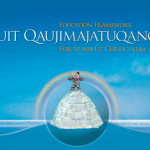1. My first resource link is simply a link to a poster; however, I feel that the poster is so important as an educator attempting to integrate First Nations learning concepts into my own teaching, and in respecting the fact that all people and cultures learn in different ways. This link is for the First Peoples Principles of Learning poster. I have one in my classroom that my students and I refer to often.
2. My second link is to the First Nations Education Steering Committee (FNESC) website. FNESC is a provincial-level committee that works to improve the quality of education and success for all First Nations learners in British Columbia. The FNESC website offers links to programs, a wide range of resources, post secondary education links (news, resources, and programs), and current as well as archived news articles related to First Nations education.
3. My third link is to a collaborative and multi-group curriculum development project based on the traditions of the Witsuwit’en people of Northwestern British Columbia. This series of twenty-two short videos (the twenty-third video is a thank you to contributors and runs like the final “credits” portion of a movie) offer audiences the opportunity to view images from the 1920’s combined with recent images and interviews of the Witsuwit’en people, showing how traditions have been preserved and carried on today. This link appealed to me because of the readings in weeks one and two of ETEC 521 which discussed media representation of First Nations people and the preservation of traditions and culture.
http://lsc.sd54.bc.ca/index.php/video-files
4. My fourth link is to an article titled ” Children as citizens of First Nations: Linking Indigenous health to early childhood development” by Margo Greenwood (Paediatr Child Health. 2005 Nov; 10(9): 553-555). This article looks at early childhood programs for First Nations children, and the connection between health and well-being and preservation of culture and traditions. Greenwood discusses the diminished level of health for First Nations people across Canada and questions the values and ideologies imparted on First Nations youth through our typical early childhood development programs. Greenwood examines the fact that programs are generally based on a “school readiness goal” that is often not connected to the values and beliefs of Indigenous people. I found this article very interesting in terms of the links between educating First Nations children in culture, language and traditions, and the potential impacts on their overall health and well-being in the future.
http://www.ncbi.nlm.nih.gov/pmc/articles/PMC2722642/
5. My fifth link is to a National Post article “Native education problems won’t be fixed through more funding, study says” (Clarke, K., August 2014). I have included this article not because I find it a valuable resource necessarily, but because I believe it calls to question how dominant society and media view “success” in terms of First Nations learners. The article cites a study done by the Fraser Institute and refers to the author of the report, Ravina Baines, as saying that “Closer ties to a provincial system or replication of the provincial structure could improve graduation rates on reserves.” Because of the readings for the first three weeks of this course, I question the article’s foundations, and I question the implication that the “problems” with First Nations education on reserves are basically that the education given is not one created by the dominant society. Is it fair to judge how “successful” a system is based only on the values and beliefs of the dominant culture? I feel the article paints a negative picture of schools on reservations and I suppose I question the approach that is taken in the article. I feel that this article could lead to valuable discussions about what “success” truly means and what it means that an institute study and media are promoting the view that reserve schools could potentially fix their “problems” by aligning themselves more closely to dominant societal educational values and beliefs. It feels like colonialism in a less overt form to me.




